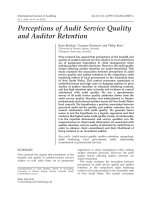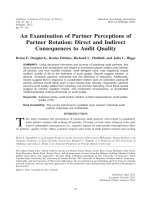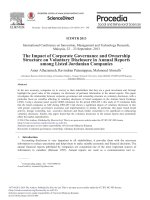Perceptions Of Marketing Activeties And Practices In Private Higher Education In Egypt The Impact Of Marketing On Institutions And Their Image
Bạn đang xem bản rút gọn của tài liệu. Xem và tải ngay bản đầy đủ của tài liệu tại đây (2.07 MB, 355 trang )
University of Southampton Research Repository
ePrints Soton
Copyright © and Moral Rights for this thesis are retained by the author and/or other
copyright owners. A copy can be downloaded for personal non-commercial
research or study, without prior permission or charge. This thesis cannot be
reproduced or quoted extensively from without first obtaining permission in writing
from the copyright holder/s. The content must not be changed in any way or sold
commercially in any format or medium without the formal permission of the
copyright holders.
When referring to this work, full bibliographic details including the author, title,
awarding institution and date of the thesis must be given e.g.
AUTHOR (year of submission) "Full thesis title", University of Southampton, name
of the University School or Department, PhD Thesis, pagination
UNIVERSITY OF SOUTHAMPTON
FACULTY OF BUSINESS AND LAW
School of Management
Perceptions of Marketing Activities and Practices in Private Higher Education in Egypt:
The Impact of Marketing on Institutions and their Image
by
Hesham Ramadan Eassa Hassaan
Thesis for the degree of Doctor of Philosophy
October 2012
UNIVERSITY OF SOUTHAMPTON
ABSTRACT
FACULTY OF BUSINESS AND LAW
SCHOOL OF MANAGEMENT
Doctor of Philosophy
PERCEPTIONS OF MARKETING ACTIVITIES AND PRACTICES IN PRIVATE HIGHER
EDUCATION IN EGYPT: THE IMPACT OF MARKETING ON INSTITUTIONS AND
THEIR IMAGE
by Hesham Ramadan Eassa Hassaan
The thesis investigates perceptions of marketing activities in private higher education, and the
extent to which these marketing activities have an impact on the image of universities.
Pragmatism was the philosophy adopted as it serves the requirement of this study. The study
used mixed methods; both quantitative and qualitative tools were used to answer the questions
of the study, and to achieve its objectives. The results showed that perceptions of marketing
were still in the early stages, in which it was perceived as practising traditional and promotional
activities, rather than as a way of thinking or a philosophy for the whole university. In general,
there was no precise definition for marketing, or indications of using a strategic marketing plan.
Product and selling approaches were usually adopted more than marketing approaches;
furthermore, product element was the dominant in the marketing mix. Marketers were more
concerned with practising traditional roles for public relations and student admissions, rather
than participating in putting together a strategic marketing plan for the university. The results
support the conclusion that there is an absence of marketing orientation in these universities.
Positioning and building university image was not among the first priorities of these universities
when implementing marketing, announcements and recruiting students being more important.
With regard to students, choosing a university was influenced by the accreditation of
qualifications, the academic reputation and the availability of the subject they wished to study.
Moreover, they were more influenced by image and reputation of the university than marketing
factors. Word-of-mouth played an important role as a source of information in the decisionmaking process. There was a strong association between satisfaction with marketing activities
relating to programme and physical evidence and their perception of their university’s image. A
conceptual model of current marketing activities and practices in private higher education in
Egypt was suggested, together with an assessment of practical issues facing private higher
education institutions. This model could be useful to understand the process of practising
marketing in developing countries in a general, and in the Middle- East specifically.
i
List of Contents
Abstract ....................................................................................................................................... i
Contents ..................................................................................................................................... iii
List of Tables ............................................................................................................................ ix
List of figures.......................................................................................................................... xiii
Declaration of Authorship.....................................................................................................xv
Acknowledgements…………………………………………….………………………..….xvii
Definitions and Abbreviations......................................................................................... xviix
Chapter 1 Introduction ......................................................................................................... 1
1.1
Marketing in higher education ...................................................................................... 1
1.2
Statement of the problem .............................................................................................. 3
1.3
Purpose of the study ...................................................................................................... 4
1.4
Significance and contribution of the research ............................................................... 5
1.5
Research Questionss and Hypotheses ........................................................................... 5
1.6
Organization of the thesis ............................................................................................. 7
Chapter 2 General background about HE in Egypt ...................................................... 9
2.1
Introduction ................................................................................................................... 9
2.2
Historical background of higher education in Egypt .................................................... 9
2.3
The system of higher education in Egypt ....................................................................13
2.4
Problems and challenges facing the HE system ...........................................................16
2.5
The evolution of private universities in Egypt .............................................................18
2.6
Ligeslation for private universities in Egypt ................................................................19
2.7
Challenges facing private universities in Egypt ...........................................................21
Chapter 3 Literature review ................................................................................................23
3.1
Introduction ..................................................................................................................23
3.2
The evolution of marketing in higher education ..........................................................23
3.2.1
The history of marketing in higher education ..........................................................25
3.2.2
Defining higher education marketing.......................................................................27
3.2.3
The importance of marketing ...................................................................................28
iii
3.3
Higher education marketing theory ............................................................................. 31
3.3.1
Marketing approaches in higher education .............................................................. 32
3.3.1.1
Product Marketing Approaches ....................................................................... 32
3.3.1.2
Approaches to services marketing ................................................................... 32
3.3.1.3
The approaches to customers of higher education ........................................... 34
3.3.2
The marketing plan and the university strategic plan .............................................. 36
3.3.2.1
Marketing research and marketing audit ......................................................... 41
3.3.2.2
Market segmentation and the target market..................................................... 42
3.3.2.3
Marketing mix ................................................................................................. 43
3.4
Positioning and building image ................................................................................... 52
3.4.1
Positioning ............................................................................................................... 52
3.4.2
Building the university image.................................................................................. 53
3.4.3
Determinants in building a successful university image ......................................... 55
3.4.3.1
Student Satisfaction and Image ....................................................................... 55
3.4.3.2
Students’ decision-making process.................................................................. 57
3.5
General view of marketing theory in higher education ............................................... 59
3.5.1
Determinants of successful marketing in higher education ..................................... 59
3.5.1.1
Responsibility for marketing ........................................................................... 60
3.5.1.2
Marketing orientation ...................................................................................... 61
3.5.1.3
Internal marketing............................................................................................ 63
3.5.2
HE marketing perceptions in developing countries ................................................. 64
3.5.3
The marketing dillemma in HE context................................................................... 65
3.5.4
Knowledge gap in marketing higher education theory ............................................ 68
Chapter 4
Methodology ............................................................................................. 77
4.1
Research paradigm ...................................................................................................... 77
4.2
Research methodology ................................................................................................ 79
4.3
Research design ........................................................................................................... 82
4.4
Data management and analysis of the qualitative phase.............................................. 84
4.4.1
Population and sampling ......................................................................................... 85
4.4.2
Research instruments ............................................................................................... 85
4.4.3
Data collection process ............................................................................................ 86
4.4.4
Data management .................................................................................................... 89
4.4.5
Data analysis ............................................................................................................ 92
4.5
Data management and analysis of the quantitative phase............................................ 93
4.5.1
Research instruments ............................................................................................... 93
4.5.1.1
Measurement and coding of study variables ................................................... 93
4.5.1.2
Validation of the research instrument ............................................................ 104
iv
4.5.1.3
4.5.2
Translation of the research instrument ...........................................................105
Data collection .......................................................................................................105
4.5.2.1
Ethical considerations ....................................................................................105
4.5.2.2
Population and Sampling ...............................................................................106
4.5.2.3
Data management process ..............................................................................107
4.5.2.4
Quantitative data analysis ..............................................................................109
CHAPTER 5 Qualitative findings and analysis ....................................................... 115
5.1
Introduction ................................................................................................................115
5.2
The process of emerging themes ................................................................................115
5.3
Senior management interviews ..................................................................................117
5.3.1
Theme one: the importance of marketing ..............................................................117
5.3.2
Theme two: marketing perception .........................................................................119
5.3.3
Theme three: marketing plan .................................................................................125
5.3.4
Theme four: university image ................................................................................127
5.4
Marketers and administrators interviews ...................................................................130
5.4.1
Theme one: importance of marketing ....................................................................130
5.4.2
Theme two: marketing perception .........................................................................133
5.4.3
Theme three: marketing strategy............................................................................139
5.4.4
Theme four: university image ................................................................................142
5.5
Focus group students ..................................................................................................144
5.5.1
Theme one: decision-making process ....................................................................144
5.5.2
Theme two: satisfaction with marketing activities.................................................148
5.5.3
Theme three: university image ...............................................................................152
5.6
Conclusion .................................................................................................................155
Chapter 6 Marketers and senior management findings ......................................... 157
6.1
Descriptive statistics ..................................................................................................157
6.1.1
Distribution of general and personal information ..................................................157
6.1.2
The perception of marketing activities...................................................................161
6.1.3
Marketing approaches ............................................................................................167
6.1.4
Challenges that impede effective implementation… .............................................169
6.1.5
Marketing objectives ..............................................................................................171
6.1.6
Factors necessary to build the university’s image..................................................172
6.1.7
Enhancing and maintaining university’ image .......................................................174
6.1.8
Involvement with marketing activities ...................................................................176
6.1.9
Marketing mix ........................................................................................................178
v
6.2
Test of hypotheses ..................................................................................................... 180
6.3
Conclusion ................................................................................................................. 191
Chapter 7
7.1
Student quantitative findings................................................................ 193
Descriptive statistcs ................................................................................................... 193
7.1.1
Personal and demographic information ................................................................. 193
7.1.2
Preferences for study in a public or private HE institutions .................................. 195
7.1.3
Decision-making process....................................................................................... 199
7.1.4
Students' satisfaction with university marketing tools........................................... 207
7.1.5
University image ................................................................................................... 209
7.1.6
University perception and description ................................................................... 210
7.1.7
Advice to freinds ................................................................................................... 212
7.1.8
Issues that students did not like in their university ................................................ 213
7.1.9
Issues students liked in their university ................................................................. 215
7.1.10
Factors that impact negatively on a university’s image..................................... 217
7.1.11
Factors that impact positively on a university’s image...................................... 219
7.2
Test of research hypotheses ....................................................................................... 221
7.3
Conclusion ................................................................................................................. 238
8. Conceptual marketing model .............................................................................. 241
8.1
Introduction ............................................................................................................... 241
8.2
Developing the conceptual marketing model ............................................................ 241
8.3
Marketing model from students’ perspective ............................................................ 243
8.4
Marketing model from senior management and marketers’ perspective ................... 247
8.5
An overview of conceptual marketing model ............................................................ 252
8.6
Conclusion ................................................................................................................. 254
Chapter 9 Conclusion and discussion ....................................................................... 255
9.1
Introduction ............................................................................................................... 255
9.2
Conclusion ................................................................................................................. 255
9.3
Contribution of the study .......................................................................................... 255
9.4
Discussion.................................................................................................................. 270
9.5
Limitations ................................................................................................................. 271
9.6
Recommendation for future research......................................................................... 271
vi
Appendices ................................................................................................................... 273
Appendix A: Inetation Letter for Universities to participate ..................................................273
Appendix B: Student questionnaire in English ......................................................................275
Appendix C: Marketers and senior management questionnaire in English............................285
Appendix D: Student questionnaire in Arabic Language .......................................................293
Appendix E: Marketers and senior management questionnaire in Arabic .............................301
Appendix F: Summary of findings in qualitative phase………………………….………….309
List of References ........................................................................................................ 315
vii
List of Tables
1.1
Number of public and private universities (1908 to 2007)………………………………….
3
3.1
Framework for a marketing plan ……………………………………………………………
38
3.2
Basic elements of an institutional plan for an organizational institution …………………...
40
3.3
The marketing mix: manufacturing and service industry definitions ………………………
44
3.4
Strengths and weakness of the 4P and 7P mixes as perceived by the respondents …………
45
3.5
The price-value matrix ……………………………………………………………………...
47
3.6
Important variables and factors when choosing a university …………………………….…
58
3.7
A brief review of marketing higher education studies………………………………………
69
4.1
Methodology and research design ………………………………………………………….
84
4.2
Codebook for participants in qualitative interviews ………………………………………..
87
4.3
Distribution of the universities and people who participated in the qualitative phase ……..
89
4.4
Code book for the students’ questionnaire …………………………………………………
99
4.5
Code book for marketers’ questionnaire (senior management and marketers) …………….
103
4.6
Reliability of scales measured in the two questionnaires …………………………………..
110
4.7
Categories of effect size…………………………………………………………………….
112
5.1
Traditional marketing communication tools ……………………………………………….
135
5.2
Issues the students liked about their universities …………………………………………..
151
5.3
Issues the students did not like about their universities ……………………………………
152
5.4
Factors that could negatively affect university image ……………………………………..
153
5.5
Perceptions of marketing according to universities studied ……………………………….
156
6.1
Frequency distribution of the sample ………………………………………………………
157
6.2
Chi- Square test for each type of university ………………………………………………..
158
6.3
Frequency distribution of attendance on marketing courses for each type of university …..
158
6.4
Frequency distributions of university size for each type of university …………………….
159
6.5
Frequency distribution of department responsible for marketing in each type of university
159
6.6
Frequency distribution of years of experience in marketing HE for each type of university
160
6.7
Frequency distribution of marketers’ academic qualifications for each type of university
161
6.8
Differences in the means rating between respondents from foreign and private universities
162
6.9
Distribution of marketing perceptions items according to level of agreement ……………..
164
6.10 Omnibus tests of model coefficients ……………………………………………………….
164
6.11 Logistic regression model summary ……………………………………………………….
165
6.12 Predicted classification of respondents according to regression model …………………….
165
6.13 Variables in the equation of logistic regression model ……………………………………..
165
ix
6.14 Mean and standard deviation of overall marketing perception by the two groups …………
166
6.15 Frequency distribution of marketing approaches adopted for each type of university ……..
167
6.16 Frequency distribution of ‘Re-coded’ marketing approaches for each type of university ….
168
6.17 Mean and Standard deviation of marketing constraints for each type of university ………..
169
6.18 Mean and standard deviation of re-coded constraints factors for each type of university ….
170
6.19 Frequency distribution of ranking marketing objectives for each type of university ………
171
6.20 Frequency distribution of factors to build university’s image for each type of university …
173
6.21 Mean and Standard deviation of factors to build image ……………………………………
174
6.22 Mean and standard deviation of categorized factors to enhance image for each type of
University……………………………………………………………………………..
175
6.23 Frequency distribution of involvement with marketing from marketers’ sample ………….
177
6.24 Frequency distributions of marketing elements for each type of university ………………..
178
6.25 Mann-Whitney test for differences in marketing perception among the two groups ………
180
6.26 Mean rank of marketing perception variables for the two groups …………………………
182
6.27 Mann-Whitney test for marketing perception ………………………………………………
184
6.28 Mean rank of marketing perception for each type of university ……………………………
184
6.29 Chi-Square test for marketing approaches adopted ……………………………………….
185
6.30 Mann-Whitney test of constraints impacting on the implementation of marketing between
the two groups ……………………………………………………………………………..
186
6.31 Mean ranks of constraints impeding marketing implementation for both groups …………
187
6.32 Mann-Whitney test of marketing objectives to focus upon between both groups …………
188
6.33 Mean rank of marketing objectives for both groups ……………………………………….
188
6.34 Mann-Whitney test for differences between the two groups over factors to enhance the
university’s image ………………………………………………………………………….
189
6.35 Mean rank of factors to enhance the university’s image for the two groups ……………….
190
7.1
Frequency distribution of sample according to age ………………………………………...
193
7.2
Frequency distribution of sample according to gender ……………………………………..
194
7.3
Frequency distribution of sample according to nationality …………………………………
194
7.4
Frequency distribution of sample according to type of university………………………….
194
7.5
Frequency distribution of sample according to subject of study …………………………...
195
7.6
Frequency distribution of preferences for HE type ………………………………………..
195
7.7
Frequency distribution of preferences for HE type according to both groups …………….
196
7.8
Mean and standard deviation of preferences to study in a public university ………………
197
7.9
Mean and standard deviation of preferences to study in a private university for both groups
………………………………………………………………………………………
198
7.10 Mean and standard deviation of factors dominant when choosing a university……………
200
7.11 Frequency distribution of factors dominant when choosing a university for both groups …
201
x
7.12 Frequency distribution of people who were most influential in decision-making ………..
203
7.13 Mean and standard deviation for sources used when collecting data ………………………
205
7.14 Mean and standard deviation for sources of information used by each group …………….
206
7.15 Mean and standard deviation of satisfaction with marketing for each group ……………..
207
7.16 Mean comparison for the 7Ps between private and foreign groups ……………………….
209
7.17 Mean and standard deviation for university image ……………………………………….
209
7.18 Mean and standard deviation for university image for each group ………………………..
209
7.19 Frequency distribution of answers regarding respondents’ perception of their universities
210
7.20 Frequency distribution of recoded attitudes towards university perception by each group
211
7.21 Frequency distribution of advice to a friend for each group ……………………………….
212
7.22 Frequency distribution of issues most disliked in a university for the two groups …………
214
7.23 Frequency distribution of issues most liked in a university for each group ………………..
216
7.24 Mean and standard deviation of factors impacting negatively on university image by both
groups ………………………………………………………………………………………
218
7.25
Mean and standard deviation of overall factors impacting negatively on university’s image
……………………………………………………………………………………….
219
7.26 Mean and standard deviation of factors impacting positively on university’s image by both
groups ……………………………………………………………………………………..
219
7.27 Mean and standard deviation of overall factors impacting negatively on university’s image
220
7.28 Chi-Square test of differences among groups for preferences of study ……………………
221
7.29 Correlation coefficient between the two groups regarding preferences to study at ………..
221
7.30 Mann-Whitney test of differences in factors dominant for decision-making ………………
222
7.31 Mean rank of dominant factors when choosing a university ……………………………….
224
7.32 Mann-Whitney test of sources of information to be used by each group …………………..
225
7.33 Mann-Whitney test of re-coded variables and sources of information to be used ………….
226
7.34 Mean rank of re-coded variables and sources of information to be used…………………...
226
7.35 Mann-Whitney test of differences in perceptions regarding university’s image …………...
227
7.36 Mean rank of image perceived by each group …………………………………………….
227
7.37 Mann-Whitney test of differences in image perceived by each group ……………………..
227
7.38 Mean rank of image perceived by each group………………………………………………
228
7.39 Chi-Square test of description of university image by each group………………………….
228
7.40 Chi-Square test of re-coded variables to university description from each group ………..
229
7.41 Mann-Whitney test of differences between the two groups towards factors that affect
negatively on their university’s image ……………………………………………………..
229
7.42 Mean rank of factors that impact negatively on university’s image for the two groups
230
7.43 Mann-Whitney test of differences between the two groups on factors that affect positively
on their university’s image ………………………………………………………………..
231
7.44 Mean rank of factors that affect positively on university image for the two groups………..
232
xi
7.45 Mann-Whitney test of differences in satisfaction of marketing activities…………………..
234
7.46 Mean rank of re-coded marketing activities for the two groups……………………………
235
7.47 Spearman’s rho test of relationship between marketing tools and image…………………..
236
7.48 Spearman’s rho test of relationship between marketing tools and image for private and
foreign universities groups ………………………………………………………………
237
xii
List of figures
1.1
Comparison between number of students in public and private universities ……………...
4
2.1
An overview of the education system in 1907……………………………………………..
13
2.2
An overview of current education system ………………………………………………..
14
2.3
Number of public and private universities (1908-2010/2011) ……………………………
19
3.1
The university and its publics ……………………………………………………………
35
3.2
Theoretical model of literature review…………………………………………………..
74
4.1
Qualitative measures to develop quantitative tools ……………………………………….
83
4.2
Categorization of factors for choosing a university ………………………………………
95
4.3
Categorization for marketing tools according to the 7Ps marketing mix …………………..
96
4.4
Categorization of sources of information …………………………………………………
97
5.1
Qualitative map…………………………………………………………………………….
116
6.1
Comparison between private and foreign universities of perceived importance of marketing
perception …………………………………………………………………………………… 163
8.1
Study design and relationships……………………………………………………………..
242
8.2
Conceptual model of student………………………………………………………………..
244
8.3
Conceptual model of senior management and marketers perspective………………………
251
8.4
Conceptual model of marketing in private HE in Egypt…………………………………….
253
xiii
DECLARATION OF AUTHORSHIP
I, Hesham Ramadan Eassa Hassaan
declare that the thesis entitled
Perceptions of Marketing Activities and Practices in Private Higher Education in Egypt:
The Impact of Marketing on Institutions and their Image
and the work presented in the thesis are both my own, and have been generated by me as the
result of my own original research. I confirm that:
this work was done wholly or mainly while in candidature for a research degree at this
University;
where any part of this thesis has previously been submitted for a degree or any other
qualification at this University or any other institution, this has been clearly stated;
where I have consulted the published work of others, this is always clearly attributed;
where I have quoted from the work of others, the source is always given. With the exception
of such quotations, this thesis is entirely my own work;
I have acknowledged all main sources of help;
where the thesis is based on work done by myself jointly with others, I have made clear
exactly what was done by others and what I have contributed myself;
none of this work has been published before submission, or [delete as appropriate] parts of
this work have been published as: [please list references]
Signed: Hesham Hassaan…………….……………………………………..
Date:…………………………………..………………………………………
xv
ACKNOWLEDGEMENTS
Praise be to Allah who has guided me through this long journey and has enabled me to complete
my thesis although of obstacles I faced during this period of my life.
I would like to express my truthful gratitude to the Egyptian government for giving me this
opportunity to travel abroad and to discover new cultures, horizons of learning and research by
sponsoring and supporting me during the period of my scholarship. Also, I would like to express
my sincere gratitude to my colleagues, professors and people who gave me help, support, advice
or ease my mission of collecting data and analysis during the phases of collecting data in my
research. I would like to send my deepest appreciations to all participants (senior managers,
marketers, administrators and students) in this research who dedicated a part of their time to
participate in this study.
Very special thanks to my professor, Dr Bahaa Al Dein Saad, who have taught me how to make
a research and made me love research career. You are my inspiration in both academic and
personal life.
I would like to express my absolute appreciations to my Father and Mother who have supported
me and encouraged me to complete my thesis. I cannot forget your favour; you were very
patient to tolerate my absence for years without complaining. On the contrary, you always
encourage me to go ahead in my road and only focus on my work. Also, I cannot forget my dear
father-in-law and my mother-in-law who tolerated the responsibility of helping my family
during my absence. Many thanks for your effort, you succeeded to make my family happy. You
are always my support in this life.
Very big thanks and my deepest appreciations to my beloved wife, Manal, who has sacrificed a
lot in order to enable me complete my thesis. She took the responsibility of the family during
the years of my scholarship and tolerated my absence for a year. I would like to tell you that I
love you, and you have played the big role in accomplishing this thesis; without your support
and encouragement, I would not be able to complete my thesis.
Finally, I would like to thank my beloved children, Mohammed, Youssef and Malak for their
gorgeous patience and love. Your love inspired me, gave me the patience and encouraged me to
work hard in order to deserve your love.
xvii
xviii
Definitions and Abbreviations
CAQDAS
Computer-Assisted Qualitative Data Analysis
CHEMPaS
Centre for Higher Education Management and Policy at Southampton
ETEP
Engineering and Technical Education Project
HE
Higher Education
HEI
Higher Education Institution
HEIs
Higher Education Institutions
NHSE
National High School Exam
SCPU
Supreme Council of Private Universities
SCU
Supreme Council of Universities
SM
Senior Management
SPSS
Statistical Package for Social Sciences
SPU
Strategic Plan Unit
UK
United Kingdom
USA
United States of America
xix
Hesham Hassaan
1.
1.1
CHAPTER1. INTRODUCTION
INTRODUCTION
MARKETING IN HIGHER EDUCATION
Today, marketing is as significant for educational institutions as it is for private profit-making
organizations. Marketing is important in order to achieve greater success in carrying out the
institutional mission, improving customer satisfaction, attracting additional resources and
improving efficiency in marketing activities (Cravens and Piercy, 2006). In particular,
universities, like other institutions, must serve the needs of their clients and stakeholders
(Maringe, 2006). The need to understand more about the role of marketing in higher education
(HE) is therefore a priority for institutional leaders and managers, and for policy makers.
According to Binsardi and Ekwulugo (2003), the basic principle of marketing is to direct all
such activities together towards achieving the wants of the customer. However, in order to
understand the practice of marketing activities in any organization, we need to recognize the
inputs which constitute the marketing system. These inputs are called the marketing mix. The
marketing mix comprises product, price, place and promotion (Goncalves, 1998). Subsequently,
a fifth element was added, namely “people” (Gray, 1991; Maringe, 2006). McColl et al. (1998)
added two further elements, which are “physical evidence” and “process” to form the seven
elements of the marketing mix (Gray, 1991; Maringe, 2006).
In current circumstances, higher education institutions are trying to adopt innovative marketing
strategies in response to increasing competition. Commonly, the purpose of this development is
either to define or to increase market share (Koc, 2006). On the other hand, marketing may face
barriers which obstruct effective implementation. These barriers include the lack of an overall
marketing strategy or policy, the absence of co-ordination of efforts and activities, and the
absence of any systematic application of formal procedures (Kinnell, 1989).
Success in using marketing activities effectively needs a clear understanding among those
responsible for implementing the marketing strategy of the role of marketing. This is the most
important factor for achieving marketing goals, especially in service organizations. This
argument is demonstrated in a study by Murphy and McGarritt (1978) who found that 90% of
the 300 US college administrators they surveyed, who were responsible for marketing activities,
did not understand the marketing concept (Kinnell, 1989). This study was undertaken over 30
years ago, but the underlying force of the argument remains true today.
To help universities to survive in the present environment, they need to adopt a marketing
strategy aimed at building a positive image for the long term, but this image is not easy to
understand. For example, some marketing professionals might think that, if they are using big
1
Hesham Hassaan
CHAPTER1. INTRODUCTION
advertising campaigns, this will give very quick results in terms of enhancing their image. In
fact, image is not primarily formulated by mass media messages, or by large campaigns
implemented by the university. On the contrary, research has shown that close personal
relationships, such as friends and family who attended the university in the past, and actual
experiences, have a much greater impact in forming the university image (Kazoleas et al.,
2001).
Although research on image has been conducted significantly in the various aspects of business
administration, less research has been undertaken in the area of service-orientated organizations
(Kazoleas et al., 2001) such as hospitals, churches and universities. In fact, marketing literature
has emphasised the role that a university can play in building a positive image, thus gaining
more benefits and a better position in terms of market share. A study by Williams and Moffitt
(1997) suggested that images controlled by an organization have a greater influence on the
image received by the respondent (cited in Kazoleas et al., 2001). From a marketing
perspective, the impact of maintaining a strong and positive image is perceived to achieve the
marketing goals. According to Nguyen and LeBlanc (2001), institutional image and reputation
can be used to predict the future outcomes from services provided, and, perhaps, the ability to
achieve customer satisfaction.
The following question needs to be considered: to what extent can marketing activities play a
role in building a positive image of the university?
By reviewing the marketing literature, it was found that those involved in the marketing of
higher education institutions should be aware of the importance of measuring their institution’s
position and image, and responding to increased competition, as all institutions are significantly
increasing their marketing activities (Ivy, 2001), in a world using market driven mechanisms.
According to Ivy (2001), image can be formed through past experience, word of mouth, and the
marketing activities of the institution. As a result, those who are responsible for universities
should consider the importance of delivering university policies that prioritise the attributes that
have the most influence on receiver satisfaction and on the overall image of the university
(Palacio et al., 2002). Building university image is not an easy process, as the desired image
must be feasible in terms of the university’s facilities and resources (Kotler and Fox, 1995). In
addition, image management of the external audiences should be integrated with studies about
internal sources of corporate image which can interpret the external image (Hatch and Schultz,
1997).
2
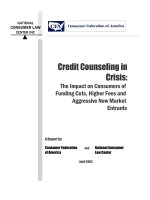
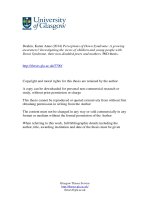
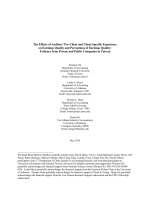
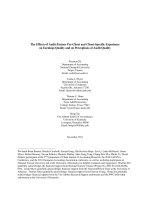
![anis - 2014 - auditors' perceptions of audit firm rotation impact on audit quality in egypt [mafr]](https://media.store123doc.com/images/document/2015_01/06/medium_ljh1420548080.jpg)
